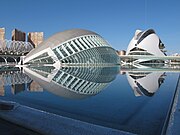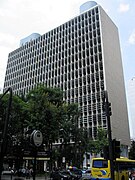Engineering:Brise soleil
Brise soleil, sometimes brise-soleil (French: [bʁiz sɔlɛj]; lit. "sun breaker"), is an architectural feature of a building that reduces heat gain within that building by deflecting sunlight.[1] The system allows low-level sun to enter a building in the mornings, evenings and during winter but cuts out direct light during summer.[2]
Architecture
Brise-soleil can comprise a variety of permanent sun-shading structures, ranging from the simple patterned concrete walls popularized by Le Corbusier in the Palace of Assembly[3] to the elaborate wing-like mechanism devised by Santiago Calatrava for the Milwaukee Art Museum[4] or the mechanical, pattern-creating devices of the Institut du Monde Arabe by Jean Nouvel.[5]
In the typical form, a horizontal projection extends from the sunside facade of a building. This is most commonly used to prevent facades with a large amount of glass from overheating during the summer. Often louvers are incorporated into the shade to prevent the high-angle summer sun falling on the facade, but also to allow the low-angle winter sun to provide some passive solar heating.[6]
Gallery
See also
References
- ↑ Borden; Meredith, Michael, eds (2012). Matter: Material Processes in Architectural Production. Routledge. p. 330.
- ↑ "Brise Soleil". Two Point Seven Facades 1 (1). 2019. https://twopointseven.co.uk/blog/f/brise-soleil. Retrieved 11 July 2020.
- ↑ "AD Classics: Palace of the Assembly / Le Corbusier" (in en-US). 2011-08-10. https://www.archdaily.com/155922/ad-classics-ad-classics-palace-of-the-assembly-le-corbusier.
- ↑ Museum, Milwaukee Art. "Burke Brise Soleil | Milwaukee Art Museum". https://mam.org/visit/burke-brise-soleil/.
- ↑ "AD Classics: Institut du Monde Arabe / Enrique Jan + Jean Nouvel + Architecture-Studio" (in en-US). 2011-10-02. https://www.archdaily.com/162101/ad-classics-institut-du-monde-arabe-jean-nouvel.
- ↑ Tolson, Simon (2014). Dictionary of Construction Terms. CRC Press. pp. 40. ISBN 9781317912354. https://books.google.com/books?id=JPVfAwAAQBAJ&q=brise+soleil&pg=PA40.
External links
- Brise soleil at the Milwaukee Art Museum
- [1] (Brise Soleil Commercial Applications)
- British-Yemini Society Influence of climate on window design
- [2] (demonstration of Brise Soleil in commercial applications)
- AD Classics: AD Classics: Palace of the Assembly / Le Corbusier
- Technical possibilities (in German)
- Museum of everyday culture (in German)
- [3] (Further reading on Brise Soleil from a supplier)
 |











